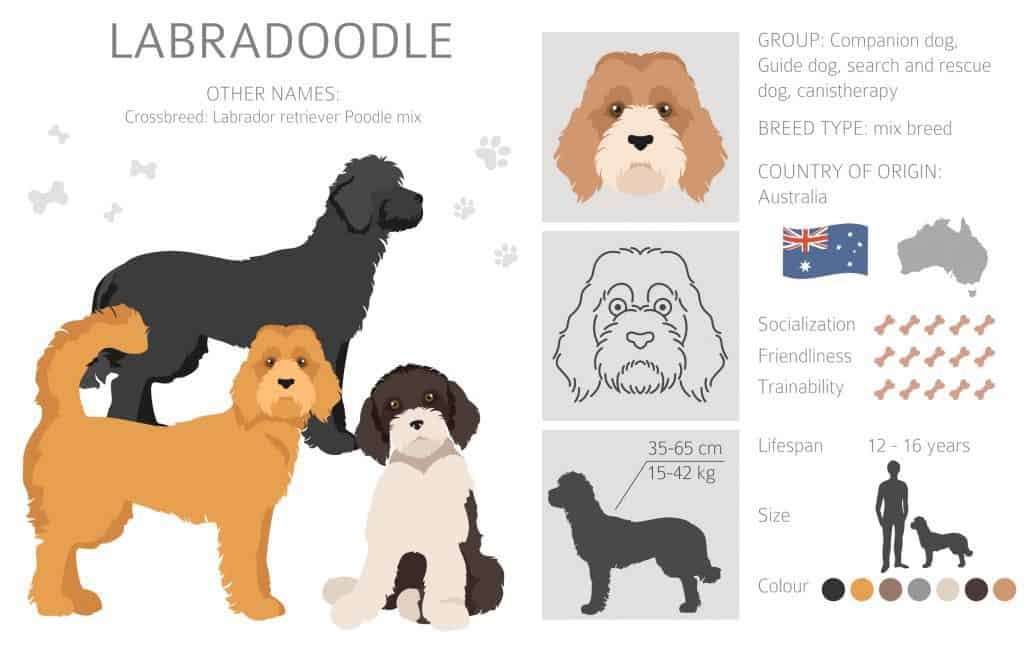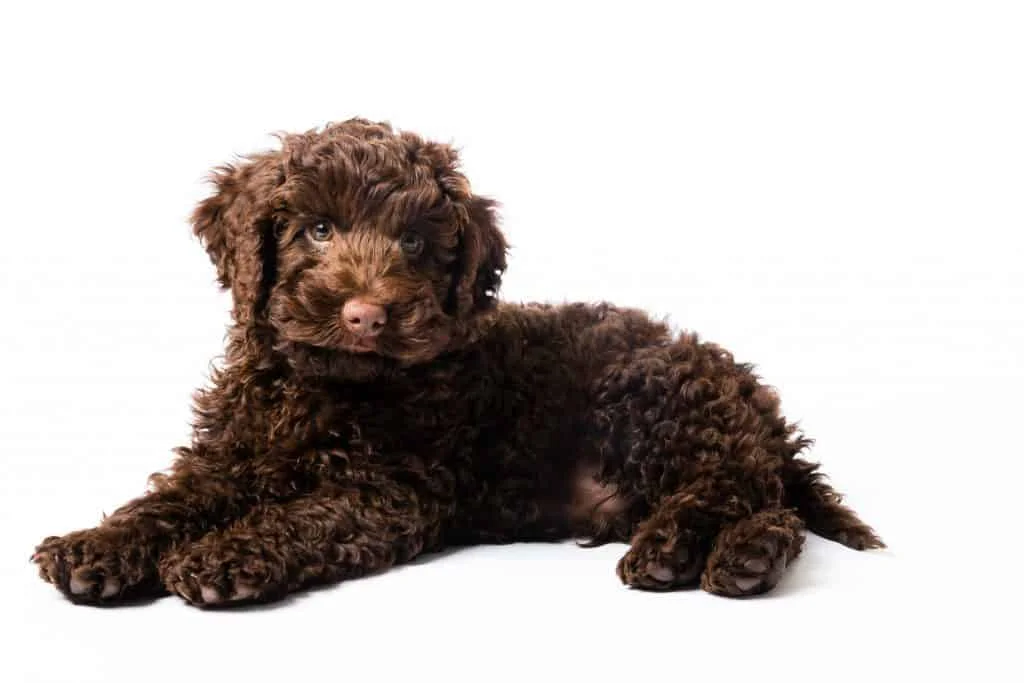Getting your first Labradoodle is an incredibly exciting process, but also one that you need to approach carefully and wisely. While Labradoodles make for excellent family pets and are friendly, loyal, and smart, there are several different types of the breed, and it is important to choose one that’s right for you.
Choosing the right Labradoodle as your newest family member can be a little tricky, given the different generations, coats, and sizes that these dogs come in. Understanding these details and aligning the dog’s needs with your own is the key to choosing the right dog.
This detailed guide explores the different Labradoodle generations and their traits to help you choose your new dog.
How Many Types of Labradoodles Are There?
Labradoodles are a hybrid mix of the Labrador Retriever and the Poodle. A first-generation Labradoodle is a mix of these two purebred dogs and therefore inherits 50% genes from each parent. Second-generation pups, on the other hand, come from breeding two Labradoodles together.
For example, there are various generations between these two, where one parent is a purebred Labrador Retriever or Poodle, and the other is a first-generation Labradoodle. These varied combinations produce dogs with similar personality traits but different sizes, coat types, and colors.
Here is a breakdown of Labradoodle generations. Generations with a ‘B’ in their title indicate a Back-cross, meaning that a Labradoodle has been bred with a purebred – usually a Poodle.
| Generation | Cross | Genetics |
| F1 | Lab and Poodle | 50% Labrador, 50% Poodle |
| F1B | F1 and Lab/Poodle | 25% Labrador, 75% Poodle |
| F1BB | F1B and Lab/Poodle | 12.5% Labrador, 87.5% Poodle |
| F2 | F1 and F1 | 50% Labrador, 50% Poodle |
| F2B | F1 and F1B | 37.5% Labrador, 62.5% Poodle |
| F2BB | F2B and Poodle | 18.75% Labrador, 81.25% Poodle |
| F3 | Multi-Generation | At least 60% Poodle |

What Are The Different Sizes of Labradoodles?
Labradoodles also come in different sizes in accordance with the sizes of their parents. Their size usually differs based on whether the Poodle parent was a Standard, Miniature, or Toy breed. While all Labradoodles are friendly and have similar personality traits, choosing the right size according to your home is essential.
| Labradoodle Size | Height | Weight |
| Standard | 21-24 inches | 50-65 pounds |
| Miniature/Medium | 17-20 inches | 30-45 pounds |
| Toy | 14-16 inches | 15-25 pounds |
It is important to keep in mind that buying a smaller dog does not mean they do not need exercise or playtime. They are still high-energy dogs that require 40-60 minutes of exertion every day. They are, however, more likely to adjust to smaller living spaces like apartments or homes without a yard.
What Do Labradoodles Cost?
Labradoodle puppies can range from $500 – $4,000, though a Standard puppy from a reputable breed should cost between $1,500 and $2,000. If you want a Miniature or Toy pup, they are likely to cost between $3,000 and $4,000.
Which Generation of Labradoodle Is Best for Allergies?
Since Labradoodles are hybrid dogs, they can never be called 100% hypoallergenic. However, their Poodle parent is a non-shedding dog, which means that some generations are ideal for homes where family members have dander allergies or more serious conditions like asthma.
The F1B, F1BB, F2B, and F2BB generations are the most likely to shed the least, and therefore ideal if you are looking for a dog that won’t shed.
While they may lightly blow out their puppy coat once and continue to shed lightly sometimes, this will be far from the high-shedding Labrador Retriever.
Which Labradoodles Are Difficult to Maintain?
If you want to buy or adopt a Labradoodle pup, it is important to understand that these are not laid-back dogs that will lounge all day and barely want to play. Regardless of the generation or size, these high-energy dogs love long walks with their humans, enjoy playtime, and demand lots of love and attention.
With any type of Labradoodle, you should be prepared to invest time and energy into their upbringing in order to keep them from developing separation anxiety.
Fortunately, these are very smart dogs that tend to learn quickly, so you can easily create a schedule and let them know when to expect walks and playtime and when to remain calm and well-behaved.
Different generations have different requirements as far as grooming goes, and what you choose depends entirely on your preferences. If you prefer to get a first-generation dog, you should be prepared to manage some amount of shedding.
This will mean regular brushing to remove stray here caught in the fur. With a Back-cross generation like F1B or F2B, you may not experience any substantial shedding, but you will have to carry out proper grooming sessions at least once every 6-8 weeks.
Non-shedding dogs usually have wavy or curly coats that tend to tangle and often grow fast, which is why they need regular bathing, brushing, and trimming.
Remember that your new dog will be an important member of your family, and it will take some effort on your part to maintain them. Rest assured, these are lovely and well-behaved dogs that adjust very well!

How to Choose a Healthy Labradoodle Puppy from a Litter
Find a reputable and ethical Labradoodle breeder to buy your puppy from, even if this costs some more money. Alternatively, you can choose to adopt a Labradoodle. When selecting your new dog, here are a few tips to keep in mind!
- Discuss lineage and size. If you are looking for a hypoallergenic dog, it is important to speak to your breeder at length about the puppies’ parents and determine if the litter is likely to be non-shedding.
You should also discuss if the parents have produced any litters in the past, how big those puppies got, and how their health is as adult dogs. - Arrange to interact with the dog. Labradoodles are generally family-oriented and are friendly towards humans and other pets. However, not every dog fits in every family.
A reputable breeder will always allow you to interact with the puppy before you buy. A healthy and happy puppy with a friendly attitude will always be eager to greet you and play with you as well as with other puppies in the litter. - Physically observe the puppy. Once you meet your new potential dog, you should be able to get an idea of their health. Healthy puppies have bright and alert eyes, clean and odorless ears, and a shiny and healthy coat.
If the puppy seems to have ear or eye allergies, a patchy or balding coat or seems lethargic, there are chances the puppy may have been bred through poor processes or may have been kept in unhygienic conditions post-birth.
If possible, it is always a good idea to meet the pup’s mom and determine if she is in good physical health.
At the end of the day, it is important to choose a puppy that is likely to adjust well with you and your family, so your home can become the puppy’s forever home.
Be aware of your responsibilities as a pet parent, choose the right type of Labradoodle for yourself, and be prepared to shower your new dog with lots of love and attention!
